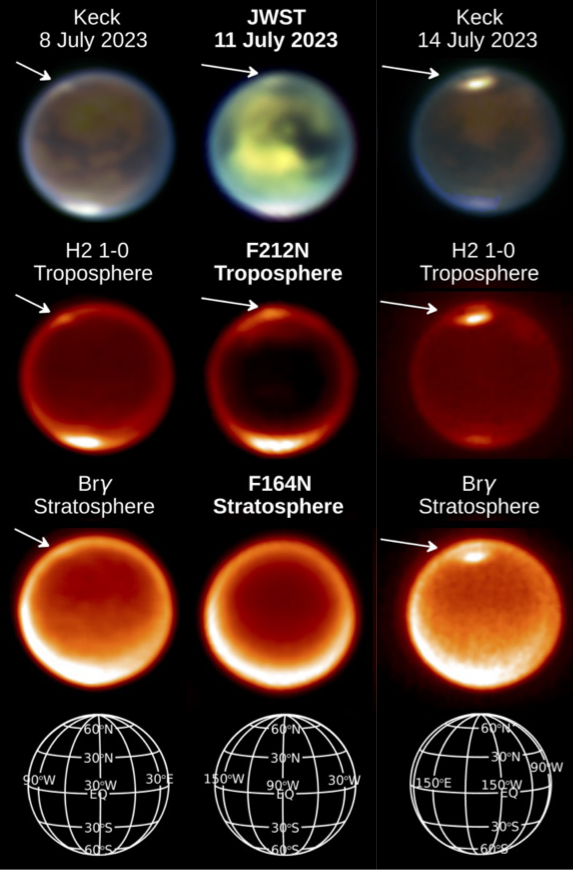- 1Planetary Systems Laboratory, NASA Goddard Space Flight Center, 8800 Greenbelt Road, Greenbelt, 20771, MD, USA
- 2LESIA, Observatoire de Paris, Université PSL, Sorbonne Université, Université Paris Cité, CNRS, Place Jules Janssen, Meudon, 92195, France
- 3ESA, European Space Astronomy Centre (ESA/ESAC), Camino Bajo del Castillo s/n, Urb. Villafranca del Castillo, Villanueva de la Cañada, 28692, Spain
- 4Department of Geophysical Sciences, University of Chicago, 5734 S. Ellis Ave, Chicago, 60615, IL, USA
- 5Department of Astronomy and Department of Earth and Planetary Science, University of California Berkeley, 501 Campbell Hall, Berkeley, 94720, USA
- 6Université Paris Cité, Institut de Physique du Globe de Paris (IPGP), CNRS, Paris, 75005, France
- 7SQUARES, Université Libre de Bruxelles, 50 Av. F.D. Roosevelt, Brussels, B-1050, Belgium
- 8Association of Universities for Research in Astronomy, 1331 Pennsylvania Ave NW, Washington, DC 20004, USA
- 9Space Telescope Science Institute, 3700 San Martin Drive, Baltimore, MD 21218, USA
- 10Department of Earth and Planetary Sciences, Yale University, 210 Whitney Avenue, New Haven, CT 06511, USA
- 11Instituto de Astrofísica de Andalucía, CSIC, Glorieta de la Astronomía, s/n, Granada, E-18008, Spain
- 12Astrochemistry Laboratory, NASA Goddard Space Flight Center, 8800 Greenbelt Road, Greenbelt, 20771, MD, USA
- 13GSMA, UMR CNRS 7331, Université de Reims Champagne-Ardenne, Campus Sciences Exactes et Naturelles, Reims, 51687, France
- 14School of Earth Sciences, University of Bristol, Queens Road, Bristol, BS8 1RJ, UK
- 15Space Exploration Sector, Johns Hopkins Applied Physics Laboratory, 11100 Johns Hopkins Road, Laurel, 20723, MD, USA
Saturn’s moon Titan is the only moon in the solar system with a dense atmosphere, composed largely of nitrogen (94.5–98.6%) and methane (5.5–1.4%). Due to the cold troposphere and surface (70–93 K) close to the triple point of methane, methane is a condensable substance in Titan’s lower atmosphere. It therefore plays a similar meteorological role to water on Earth, evaporating from the surface and reaching the middle troposphere, where methane clouds form and rainfall occurs, in changing seasonal patterns. In the middle and upper atmosphere, methane is processed by photochemistry and at high altitudes forms solid organic haze particles or even PAHs (polycyclic aromatic hydrocarbons). These particles are thought to be the building blocks of stratospheric aerosols as they drift downwards and grow in size to form a global haze layer in the stratosphere, which lends Titan its golden hue at visible wavelengths. In the stratosphere, slow seasonal changes in composition and haze distribution indicate the seasonal reversal of Titan’s global meridional circulation every 14.75 Earth years.
Since the end of the Cassini-Huygens mission in September 2017 our ability to monitor Titan’s changing atmosphere has been curtailed, since we have lacked the ability to view Titan unimpeded by the Earth’s atmosphere across all infrared wavelengths. Nevertheless, using ground-based adaptive optics (AO) imaging from the Keck observatory on Maunakea, cloud monitoring was possible, although only in some near infrared (NIR) spectral windows. With the commissioning of the James Webb Space Telescope (JWST) in 2022 it became possible to view Titan once more at wavelengths from ∼1.0 to 28.0 μm.
In this article we report results of JWST imaging and spectroscopy of Titan that occurred in November 2022 and July 2023, using three of the four observatory instruments. We also report on contemporaneous ground-based observations with the Keck NIRC2 camera that provided even higher spatial resolution imaging over a wider time range, but in a more limited set of filters. Imaging data from JWST and Keck reveals clouds at mid and high northern latitudes at different altitudes, suggestive of convection at the latitudes of the northern lakes and seas. Spectroscopy with JWST/NIRSpec enabled the detection of the CO2 4.3-μm bands and measurement of the detailed structure of the CO 4.7-μm non-LTE emission. Finally, with JWST/MIRI we made the first detection of the CH3 radical, opening new views into the photochemistry occurring in the upper atmosphere.
Together, these results provide new insights into the changes in the composition and meteorology of Titan’s atmosphere that have occurred since the end of Cassini-Huygens in 2017, as Titan’s late northern summer ebbs towards the upcoming fall equinox in 2025.

Figure 1: JWST (July 11th) and Keck (July 8th and 14th) observations of Titan. Upper row: RGB color composite images. JWST: blue=1.4 mm, green=1.5 mm, blue=2.0 mm (filters F140M, F150W, and F200W, respectively. Keck: blue=2.13 mm, green=2.12 red=2.06 mm (H2 1-0, Kp, and He1b, respectively). Second row: single-wavelength images taken by JWST and Keck at 2.12 mm sensitive to emission from Titan’s lower troposphere. Third row: emission at 1.64 mm (JWST) and 2.17 mm (Keck) sensitive to Titan’s upper troposphere and stratosphere. Fourth row: Titan orientation on the sky as seen on the different dates. Clouds are seen at higher altitudes on July 14th than earlier on July 8th and 11th, suggesting upward convection.
How to cite: Nixon, C., Bezard, B., Cornet, T., Coy, B., de Pater, I., Es-Sayeh, M., Hammel, H., Holler, B., Lellouch, E., Lombardo, N., López-Puertas, M., Lora, J., Milam, S., Rannou, P., Rodriguez, S., Teanby, N., and Turtle, E.: Titan’s Atmosphere in Late Northern Summer from JWST and Keck Observations, Europlanet Science Congress 2024, Berlin, Germany, 8–13 Sep 2024, EPSC2024-670, https://doi.org/10.5194/epsc2024-670, 2024.